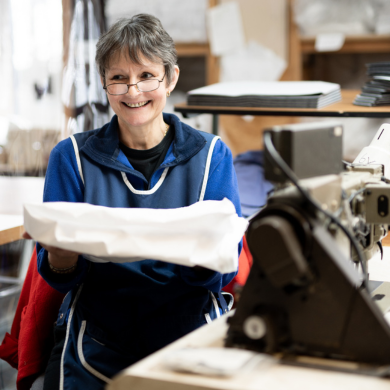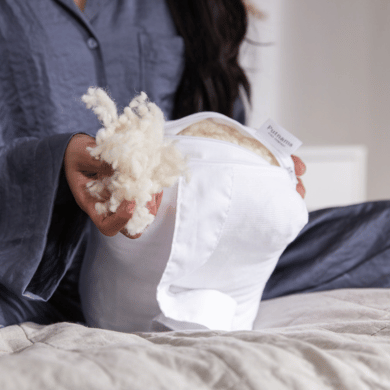
How To Choose the Best Bedding for Children: A Complete Guide
When it comes to ensuring a good night's rest, the importance of quality bedding for your children cannot be overstated. From supporting children’s sleep health to ensuring comfort and safety, choosing the right bedding is a significant decision for many parents, childcare professionals, and home decor enthusiasts.
With so many options on the market, narrowing down the best pillows for kids, toddler pillows, and duvets can feel overwhelming. This guide will help answer your most pressing questions, such as what to look for in kids bedding, what material is best, how often it should be changed, and what size duvet works best, all while highlighting premium offerings by Putnams.
British Wool Duvet - Cot Bed - Toddler - Excellent duvet and pillow. I researched quite a bit and love the quality of this set. Happy knowing my toddler has the best materials during sleep. Buy local. - Peter C
Why Children’s Bedding Matters
Children rely on healthy sleep to support their growth and cognitive development, and comfortable, safe bedding plays a huge role in achieving quality sleep. Fitted bedding eliminates discomfort, manufacturing-safe materials prevent allergic reactions, and timeless designs make bedroom spaces more inviting.
Whether you’re furnishing a nursery, upgrading a toddler bed, or purchasing for older children, selecting age-appropriate bedding is the foundation for healthy rest routines.
What to Look for in Kids’ Bedding
When considering bedding for children, it's essential to balance practicality with comfort. Here are the key factors you should assess:
1. Size and Fit
Children’s bedding must fit snugly on their mattress to prevent bunching that could deter sleep quality. For example:
- Toddler pillows are typically smaller than standard pillows and designed to offer gentle neck support.
- Common toddler bed duvet sizes, such as 120x150 cm, match mattresses measuring 70x140 cm.
Putnams offers products tailored for young ones, such as perfectly proportioned toddler pillows and supportive duvets that enhance sleep ergonomics and fit seamlessly.
2. Breathable Materials
Prioritise materials that are gentle on the skin and promote airflow to prevent overheating. British will and and cotton are popular choices due to their softness and breathability. For an environmentally conscious choice, opt for organic textiles with no harmful dyes or chemicals.
Consider Putnams’ hypoallergenic pillows, crafted with materials safe for sensitive or allergy-prone children.
3. Safety and Certifications
Young children spend extended periods in bed, making safety non-negotiable. Bedding should comply with safety standards, particularly regarding flammability (for duvets) or chemical-free finishes.
Certifications such as OEKO-TEX ensure harmful substances are absent.
See also - Sleep Naturally: How Organic Bedding Can Transform Your Health
4. Design and Fun
Bedding that reflects children's personality, using fun colours, animals, or geometric patterns, can make bedtime more appealing.
However, always balance visual appeal with the durability of design. Prints that resist fading after washes are ideal. And don't forget the attraction of Peppa Pig can quickly become your child's nemesis as the months (sometimes weeks) roll by!
Putnams' bedding line offers timeless yet playful options that resonate with children while maintaining style neutrality.
5. Durability
Invest in bedding sets that maintain their shape and softness after multiple washes. Children can be tough on their bedding, so strength is a worthwhile consideration.
Putnams’ products are designed to be durable and long-lasting, promising value for money and fewer replacements.
What Material is Best for Kids’ Bedding?
The choice of fabric significantly impacts comfort and longevity. Here’s a breakdown of ideal materials for children’s bedding:
1. Cotton
- Soft, breathable, and gentle on the skin.
- Excellent for regulating body temperature.
- Durable and easy to clean.
- Works well for all seasons.
2. British Wool
- Eco-friendly, naturally hypoallergenic and bio-degradable at end-of-life.
- Regulates temperature effectively, keeping kids warm in winter and cool in summer.
-
Anti-allergy, hypoallergenic, temperature-regulating and moisture-wicking.
3. Linen
- Highly durable and hypoallergenic.
- Becomes softer with every wash but may require extra maintenance.
4. Blended Fabrics
- Durable and cost-effective but may include unnatural components. Avoid bedding sets with synthetic-heavy blends as they lack breathability and may cause itchiness.
Pro tip: Look out for Putnams’ children and toddler bedding handmade by mums, which incorporates organic fibres designed to protect sensitive skin.
How Often Should You Change Children’s Bedding?
Hygiene is crucial for children’s bedding. Change their sheets and pillowcases weekly, as this ensures allergens, dust, and bacteria don’t accumulate. For younger children prone to spills or accidents, consider adding a mattress protector or washable layers.
Pillows and duvets should be assessed periodically:
- Pillow Refresh: Replace pillows every 1-2 years to maintain adequate neck support and prevent flattening.
- Duvet Update: Invest in a new duvet every 3-5 years, ensuring filling remains evenly distributed and intact. Children's duvets should be replaced as thye grow.
Putnams’ high-quality toddler duvets are both washable and durable, offering parents an option for regular upkeep that doesn’t compromise comfort.
What Size Duvet is Best for Your Child?
Choosing the right duvet size is essential for comfort and safety. A duvet that is too large can overwhelm a small bed, while one that is too small leaves children exposed during the night.
Here’s a quick guide:
- Toddler Beds (70x140 cm): Opt for a 120x150 cm duvet. (Toddler Duvet)
- Single Beds (90x200 cm): Use a 140x200 cm duvet.
- Junior Beds (80x160 cm): Tailored duvets ranging slightly smaller than single sizes are perfect.
Putnams offers appropriately sized duvets for growing children, ensuring a balance between coverage and snugness. Please note we also offer a pram duvet (78x56cm) to keep your little bundle of joy warm and snug on those long walks!
Why Choose Putnams for Children’s Bedding?
Putnams has been at the forefront of sleep comfort solutions, offering expertly curated bedding for all ages. Their children’s collection prioritises:
- Safety Standards: Hypoallergenic materials free of harmful chemicals or dyes.
- Ergonomic Design: Products like their toddler pillows focus on spinal alignment, crucial for developing bodies.
- Durability: Long-lasting materials and construction that stand the test of wear, tear, and regular washing.
Combine this with Putnams' range of duvets and pillowcases designed specifically for children, and you’ll find no shortage of high-quality sleep solutions.
Final Thoughts on Choosing Children’s Bedding
Bedding is the foundation of children’s sleep health, and choosing snug, safe, and fun designs helps foster better rest habits. By assessing the size, material, and durability of bedding, you can create a comfortable sleep environment that your children will love.
If you're ready to invest in your child’s sleep health, explore Putnams' selection of premium toddler pillows, kids’ duvets, and hypoallergenic options.
Sleep better and grow better with Putnams, because a good night’s rest is the least your little ones deserve.

















Leave a comment